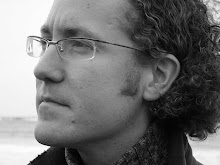Last Monday (23/10/06) I had the good fortune of attending the opening of a new interactive art exhibit at the Leeds Metropolitan Gallery. The exhibit is called Re-possessed and presents a collection of interactive art installations inspired by Alfred Hitchcock’s Vertigo. Each installation takes a section of the film and provides the participants with novel ways of exploring the film, their experience of it, and the issues of power, gender, and voyeurism that are so prominent in the film. The exhibit runs until 18th November and I highly recommend it if you are interested in film or just want to play with some highly innovative interactive exhibits.
The main reason I was invited down for the opening was because one of the artists, Richard Stevens had stumbled across my research whilst looking for references about applying eye tracking to film. His installation, Re-viewed uses a Tobii eyetracker to record viewer’s eye movements whilst watching scenes from Vertigo and then represents the eye movements using some very interesting visualisations that Richard and his students have created. These visualisations give the visitors an insight into their perceptual experience of film that they have never previously had. It also emphasises group differences such as between Male and Female viewers. Given that gender politics and the resulting power relationships are very prominent themes in Hitchcock’s work (see Laura Mulvey’s article on the Male Gaze in her 1975 book “Visual Pleasure in Narrative Cinema”) this method of using eyetracking to extract the gender differences in the viewing experience could prove very informative.
The reason why Richard contacted me is because he and his collaborator, Tony Renshaw were uncertain how to interpret the eye movement data given that so little work has been done in relation to film. They also needed some clear way of expressing any group differences that they observed. Currently, Richard’s visualisations can display the moment by moment differences but in order to report and quantify these differences precise measurements are required. I have encountered similar problems with my own eye tracking work and have been developing suitable measurements. Hopefully I will be able to aid Richard and Tony in the analysis of their data and we will find some interesting group differences. We’ll then work towards publications based on the results. I’ll keep you posted if anything emerges.
I am very excited about this exhibit as, to my knowledge it is the first time eye tracking of film has been performed on such a large scale with a large cross-section of the population. Most eye tracking studies (all Psychology studies for that matter) are usually conducted on University undergraduates; the most easily accessible subject pool for university researchers. The number of subjects eye tracked is also usually less than 20 so there is no scope for exploring group differences. Hopefully, through the development of new measurement techniques and automation of the analysis we can extract some interesting results from this study which will further our understanding of the viewing experience.
So, if you are any where near Leeds in the next two weeks head down to the Leeds Met Gallery. You’ll be furthering scientific knowledge whilst having a fun and informative time.




1 comment:
HI Tim
I 'm a ex-student from Mexico trying to start a master's degree in film studies at the University of Edinburgh. I would like to know your appreciation of the school as a student. You know, schools can teel anything about themselves, but the reality sometimes is quite different from what is written in ther "prospectus" leaflets.
Post a Comment